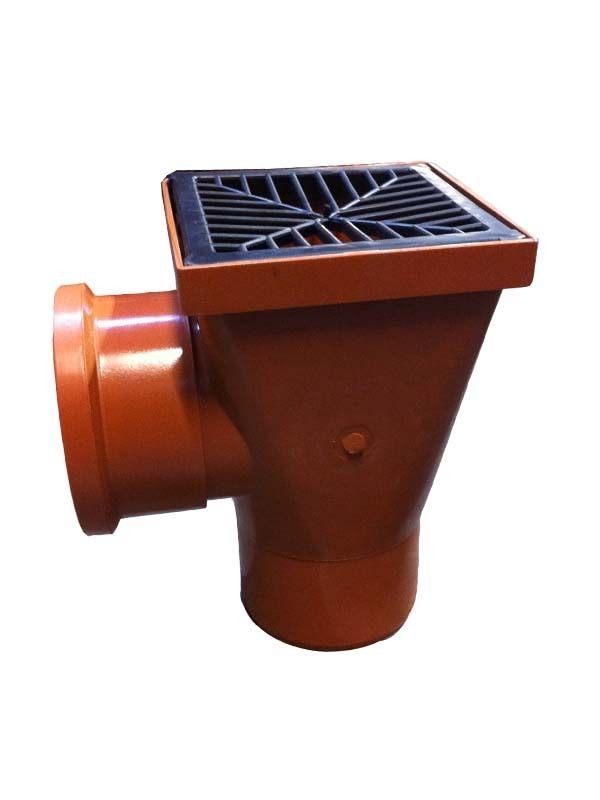Gulley

|
A gulley is a fitting with a chamber which is designed to collect rainwater, wastewater and groundwater, conveying it to an underground surface-water sewer. Gullies can be used to drain waste water and rainfall from buildings, large paved areas and roadsides, pedestrian areas, parking areas, pavements, roofs and so on.
Usually buried in the ground, the gulley’s configuration typically involves a chamber and a trap (sometimes referred to as a trapped gulley), while its top surface often has a grille over which a waste or rainwater pipe can discharge. Trapped gullies can also be used to take waste water from household sinks and baths. Thus, gullies can collect rainwater from roofs, impervious surfaces and waste water from buildings. When used to drain large areas, they are frequently called yard gullies or road gullies.
The gulley’s top grille is usually designed to prevent leaves, litter and large objects from blocking the system, while the trap – which can be a P-, Q- or S-type – prevents odours from escaping into the environment and can make it difficult for rats to reach the surface. Over time, the level of sediment collecting in a trap can cause blockages which may require manual removal or mechanical suction.
Traditionally, gullies were made from cast iron or vitrified clay, but these have been largely superseded by PVC which is both cheaper and lighter whilst still being durable.
When a trapped gulley features a below-ground inlet coming from another gulley or water source, it is termed a back-inlet gulley. The horizontal inlet is typically located below the top grille but above the level of the water seal. Many gulley types provide the facility to rod the system when a blockage occurs down the line.
A gulley can also be a grated opening in a road gutter; or in a hard-landscaped area to evacuate rainwater from the surface.
Gulleys can also be used internally, e.g buried in the floor in a wet room application.
[edit] Related articles on Designing Buildings Wiki
- Approved Document H.
- Difference between drains and sewers.
- Drainage stack.
- Drains.
- Grease management.
- Groundwater control in urban areas.
- Gully.
- Highway drainage.
- Invert
- Pipelines.
- Pipework.
- Public sewer.
- Rain gutter.
- Rainwater downpipe.
- Safe working in drains and sewers.
- Sewer construction.
- Sewerage.
- Soakaway.
- Soil vent pipe.
- Waste water.
- Water transfers and interconnections.
Featured articles and news
The UK's Modern Industrial Strategy: A 10 year plan
Previous consultation criticism, current key elements and general support with some persisting reservations.
Building Safety Regulator reforms
New roles, new staff and a new fast track service pave the way for a single construction regulator.
Architectural Technologist CPDs and Communications
CIAT CPD… and how you can do it!
Cooling centres and cool spaces
Managing extreme heat in cities by directing the public to places for heat stress relief and water sources.
Winter gardens: A brief history and warm variations
Extending the season with glass in different forms and terms.
Restoring Great Yarmouth's Winter Gardens
Transforming one of the least sustainable constructions imaginable.
Construction Skills Mission Board launch sector drive
Newly formed government and industry collaboration set strategy for recruiting an additional 100,000 construction workers a year.
New Architects Code comes into effect in September 2025
ARB Architects Code of Conduct and Practice available with ongoing consultation regarding guidance.
Welsh Skills Body (Medr) launches ambitious plan
The new skills body brings together funding and regulation of tertiary education and research for the devolved nation.
Paul Gandy FCIOB announced as next CIOB President
Former Tilbury Douglas CEO takes helm.
UK Infrastructure: A 10 Year Strategy. In brief with reactions
With the National Infrastructure and Service Transformation Authority (NISTA).
Ebenezer Howard: inventor of the garden city. Book review.
The Grenfell Tower fire, eight years on
A time to pause and reflect as Dubai tower block fire reported just before anniversary.
Airtightness Topic Guide BSRIA TG 27/2025
Explaining the basics of airtightness, what it is, why it's important, when it's required and how it's carried out.
Construction contract awards hit lowest point of 2025
Plummeting for second consecutive month, intensifying concerns for housing and infrastructure goals.
Understanding Mental Health in the Built Environment 2025
Examining the state of mental health in construction, shedding light on levels of stress, anxiety and depression.





















